
It has always been a little dream of mine to visit Brittany and explore its cidre. Luckily for me, I could fulfill that dream at least to a certain extent as I was invited to be a cider judge in the 9th regional cider competition in Brittany (Le 9ème Concours Régional des produits cidricoles bretons) organised by La Maison Cidricole de Bretagne taking place on June 10 2024 in Lorient, in the Morbihan region. My initial plan was to spend at least a week in Brittany and combine the cider judging with some time off to do some sightseeing, explore the local cidre and feel the atmosphere of picturesque Brittany. However, due to personal reasons, I couldn’t consider taking such a long leave in that time. Nevertheless, since I still wanted to be a cider judge in that Breton cider competition, I decided to make a rather intense hop-on hop-off trip to Normandy, Brittany and Paris. All in 3 days.
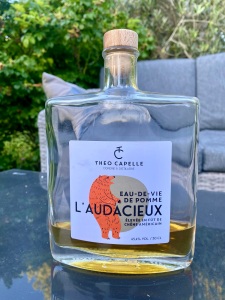
On Sunday evening, after landing at Paris-Orly airport, I took a bus to Caen, Normandy. On the motorway, I could observe a lot of traffic towards Paris, which I assumed to be caused by the Parisians heading back from their country houses in Normandy to their apartments in Paris. I could tell that I was already in Normandy when through the bus window I saw a lot of apple orchards with cows, sheep and other livestock grazing in the green grass. This is when you know that you are in Normandy. How I missed that! Especially that my firs visit to Normandy was in 2018 (here is my visit recap). Once I reached Caen, my dear friend and fellow pommelier, Yann Gilles, fetched me from the bus station and let me stay at his house and dine with his family. After dinner, we sat in Yann’s beautiful garden and tried a delicious eau-de-vie made by Theo Capelle that was aged in American oak barrels. As I learned from Yann, it can’t be called a calvados since one of the criteria that an eau-de-vie has to meet in order to be called calvados is aging in French oak barrels, which in the case of this particular eau-de-vie was not the case.
On the next day, together with Yann we left Caen, Normandy at 6 am to arrive in time for the cider competition in Lorient, Brittany. During our drive, I had a very interesting conversation with Yann about his work as a cider consultant in Normandy, where he helps cidermakers during the cidermaking process choosing the right blends and preventing things from going wrong. Yann visits cidermakers he works with once a month and based on measurements such as pH, sugar level, etc. and sensory evaluation of samples, he advises cideries on the next steps. At that moment I realised that there is still a huge difference between how cider is being made in France and in most countries that don’t have a cidermaking or even winemaking heritage as here making cider is a mix of science and art, while elsewhere it is most of the time pitching yeast to apple juice pressed from a blend of various apple varieties in unknown proportions and waiting for the outcome without any intervention in-between. Cidermakers from most of continental Europe have still a lot to learn. On another note, Yann also told me that Calvados makers, who until now had been making only Calvados from their cidre, recently decided to add cidre to their product portfolio. With a decline in wine consumption in France, and cidre being a low-alcoholic beverage, they see cidre now as a good business opportunity. Another proof that cider is growing!
Le 9ème Concours Régional des produits cidricoles bretons
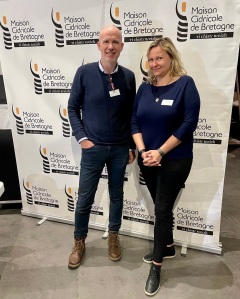
Once we reached the venue, which was located in La Cité de la Voile Éric Tabarly close to Lorient and after registering for the event, I was overwhelmed to see so many judges participating in the competition. Admittedly, there were two judging sessions, one in the morning and one in the afternoon and the judges could either sign up for both sessions or one session and a guided tour of La Cité de la Voile Éric Tabarly being famous for hosting sailing competitions. But still, there were more cider judges than I had encountered before! Most of the judges were cidermakers, restaurant owners, distributors so people who work with cider on a regular basis. And, everyone but me was French. I was the only non-French cider judge there. And, I don’t even speak French. Oh wow! Anyhow, before I proceed with the description of the jury tasting, I just wanted to say a few words about the 9eme Concours Regional Cidricole de Bretagne.
Although cidre has been made in Brittany for many centuries and has a very strong cidre tradition, a cider competition for professional cidermakers from Brittany was established only 9 years ago. Thanks to the initiative of the La Maison Cidricole de Bretagne, this has changed and cideries can enter their products in a total of 18 categories that include cidre, pommeau, eau-de-vie de cidre or apple juice (sic!) and see how they perform compared to other fellow professional cidremakers in Brittany. That being said, it is important to highlight that Concours Régional des produits cidricoles bretons is a regional competition so only cidermakers from Brittany can enter their products. As a side note, there is another cider competition in Brittany addressing only hobby cidermakers that will be held this year for the 111th time, 111ème Concours de Cidre de Fouesnant. Btw, if you are a hobby cidermaker (you don’t have to be from France to participate) and would like to enter your cider, get in touch with me I will share with you more details.
Jury tasting
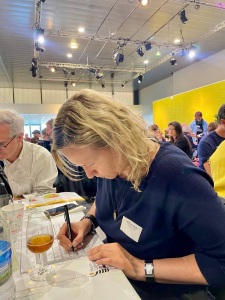
After participating over the years in numerous cider competitions across Europe, I am used to evaluating between 20-30 samples during one judging panel. Therefore, I was rather surprised to see that together with 4 other jury members I was supposed to evaluate only 6 ciders, all from the category Cidre AOP Cornouaille. Just a note that Cidre AOP Cornouaille is the only region in Brittany with a Protected Geographic Origin (PGO). But as I mentioned earlier, there were a lot of judges and two judging sessions. Anyhow, before the judging, we have been given the characteristics that a Cidre AOP Cornouaille should express, namely golden-orange color, on the nose complex fruity aromas (apple, peach, citrus, floral) along with notes of spices and vegetal notes. On the palate, tannic with a good balance of sugar and acid. There were 5 judges per judging panel, apart from me, there were also Yann Gilles and Yves Maho, the owner of Cidrerie du Pays D’Auray who I previously met at CiderWorld’22 and ’24 in Frankfurt and who also happened to be the president of the organisation that established this cidre competition, La Maison Cidricole de Bretagne. Two English-speaking Frenchmen and both judging with me. Lucky me!
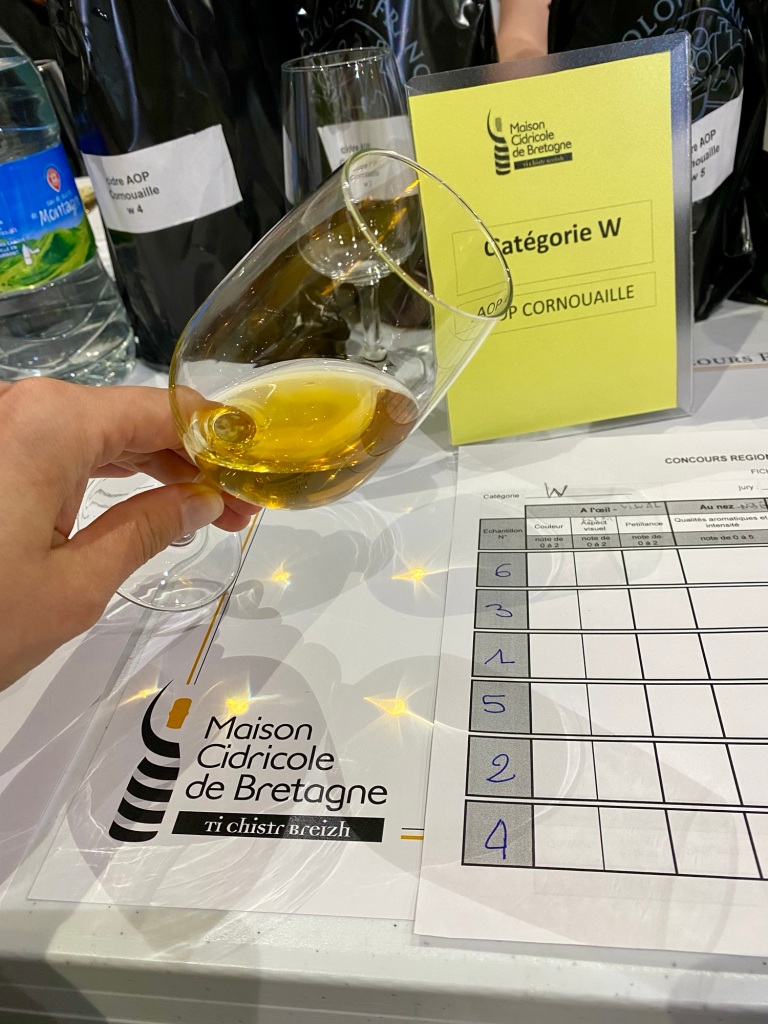


The judging process differed from what I was used to in previous cider competitions also in other aspects. Apart from the mentioned number of samples, the bottles of ciders entered into the competition were standing on our table and came in a black plastic bag so nobody could identify the cidermaker and sampled cidre. Each bottle carried a number and judges had to pour samples into a glass on their own and evaluate them at their own pace. The scoring sheet was also quite simple. Points were given for the colour (max. 2 points), level of carbonation (max. 2 points), clarity (max. 2 points), overall scent (max. 5 points) and overall taste (max. 5 points) so the max. number of points was 16. After the evaluation, the points were calculated and judges exchanged about evaluated ciders. In case of discrepancies, the judges jointly discussed the reasons for their decisions. The cidre that scored the most points won Or (Gold), the second best got Argent (Silver). Even though I speak several languages unfortunately French is not one of them, I could easily communicate in English as everyone understood me and if I didn’t understand someone’s reply in French, Yann and Yves were there to help me with translation from French to English or even to German in case of Yves. Interestingly, on my judging panel 3 out of 6 ciders were faulty. One of the bottles had a cork taint, the other two had cider sickness. I was rather astonished that someone would enter a cidre with such a clear fault. But the remaining three ciders were indeed either good or even very good. And, the awarded cider (as I found out later was from Les Vergers de Kermao) was a real beauty. The full list of winners can be found here.
Visit to Cidrerie du Pays D’Auray
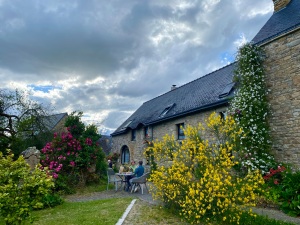
After the cider competition, together with Yves, we drove to Auray as this is where Cidrerie du Pays D’Auray, a cidery owned by the family of Yves is based. And, where my accommodation for the night was. When we got there, all I could say was “Wow…, wow…, wow….”. The place was idyllic. It was located in a traditional Brittany rural stone farmhouse surrounded by flowers, shrubs and flowering trees. A perfect place to relax, slow down and enjoy the beauty of the countryside over a glass of cidre. The family Maho has been living in the house for 9 generations. Yves said that he can still remember that the roof of the building used to be originally thatched. And, that his family used to keep livestock incl. pigs. Interestingly, both grandpas of Yves, from both mother’s and father’s side made cidre for their use. So Yves might be the first generation making cidre for living but he grew up being surrounded by cidremakers. Apart from the cidery, there is also a guesthouse managed by the sister of Yves and a cider shop, where Yves’ mother helps out. She might be over 80 years old but you would never tell her age by looking at her. This is how active and bright she is. If you want to live a long life, you must live in Brittany.

Annually, Yves makes, if I got it right, approx. 90.000 bottles of cidre but he’s planning to increase the volume to 130.000 bottles. Yves is not only a talented cidermaker (I praised his ciders already during my visit recap to CiderWorld’22 and ’24) but also a very intellectual one. He returned to Brittany to make cider after living and working in the Finance sector in Germany, Brazil and Algeria. As you have rightly guessed, this is when he picked up German. He said that he hates making Guillevic, which is the only singlevarietal cidre in Brittany as it is a really difficult apple variety to grow. Apparently, for an apple fruit it is completely uninteresting but when it turns to cidre it develops such a depth of flavours that is worth the hassle.
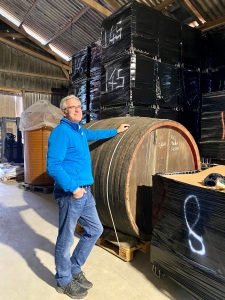
Yves does not only make cider, pommeau or eau de vie de cidre. Interestingly, he also likes to experiment a lot and makes mead with honey from his hive. Usually when making mead, one dilutes mead with water. Yves, however, instead of adding water to his mead, adds his cidre. In addition, recently he acquired a used French oak barrel from a winemaker in Alsace that can fit 2000 litres and is planning to age his cidre in it. I look forward to trying it!
Astonishingly, almost all of the guests staying at the guesthouse run by Yves’ sister who I met at breakfast came from Germany. When I asked them how they came across Yves, they replied that they watched an episode of a documentary program called Wunderschön about Brittany that featured Yves (here is the link if you would like to watch it-it’s in German only). I might be living in Germany but since I don’t watch TV, I’ve never heard of that TV show before. After watching that episode, I wasn’t surprised that Germans started coming here making the guesthouse fully booked months in advance!



Extra But won Gold at CiderWorld’24
Galette and cidre at Breizh Cafe, Paris
Auray might be located over 500km away from Paris but thanks to TGV, it takes only a little over 3hrs to get there. So 4 hours after Yves brought me to the train station in Auray, and since I still had a few hours left in Paris before my return flight to Berlin, I paid a visit to a creperie BREIZH Cafe that specialises in galette and has a cider menu. They have a few locations in Paris but I went to the one that was closest to the tourist areas to take a glimpse at the Seine, the Louvre and the Notre Dame Cathedral afterwards before heading to Paris CDG airport and returning to Berlin. Apart from the cidre menu they offer cidre by the glass and everyday there is a different one. On the day I was there, they were pouring Taranis from Domaine Johanna Cecillion. Both galettes and cidre were very tasty so I hope Breizh Cafe can expand to Berlin soon. I certainly wouldn’t mind.
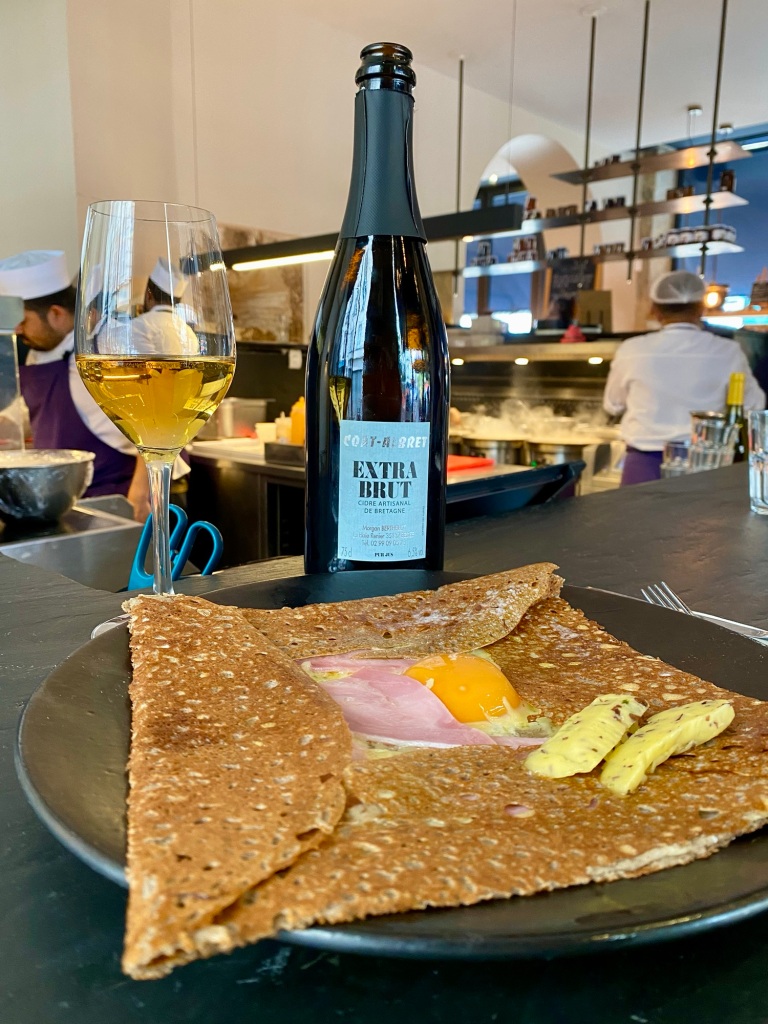
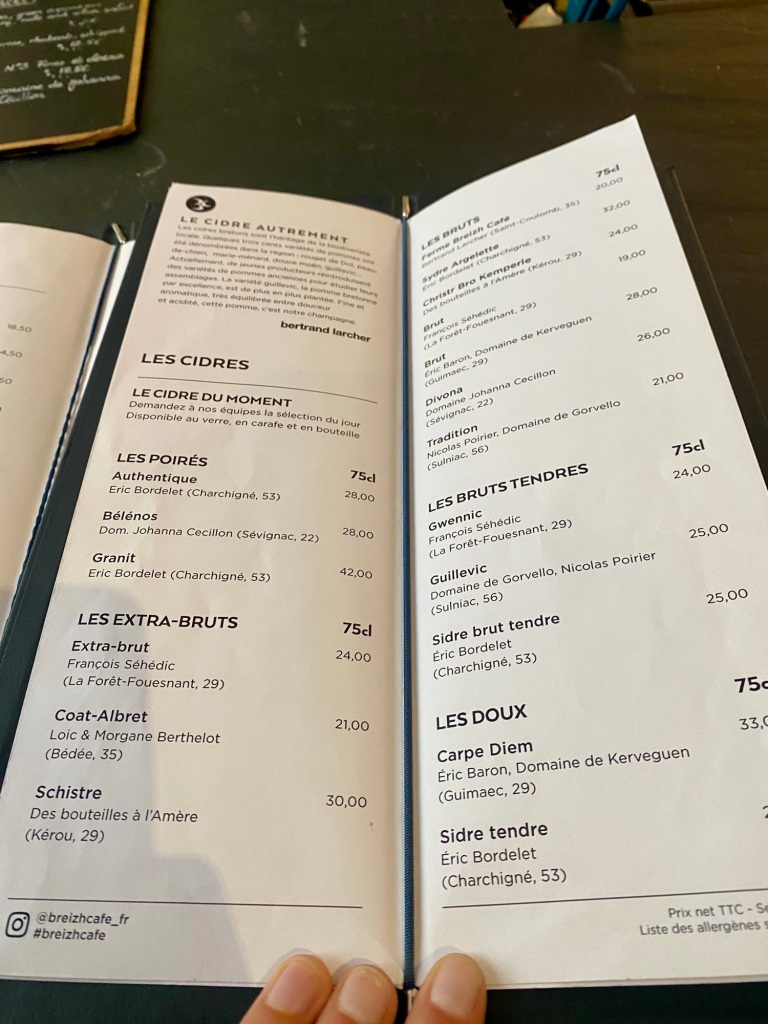
Closing remarks
I have the impression that I was away for a week, not for three days. It might have been an extremely short and intense trip but it was worth it. Participating in a regional cider competition in Brittany was a true privilege and honour and a completely new and interesting experience for me. Also, being able to evaluate Brittany cidre from the category of Cidre AOP Cornouaille was a very valuable lesson. And, even though I think I was the only non-French cider judge without any knowledge of French, during judging I managed to communicate with other cider judges without any issues (mainly thanks to Yann and Yves) and make new cider connections. I enjoyed the atmosphere of this cider competition as everyone was so welcoming and warm to me.
I am also very happy that I could visit at least one cidrery during that trip and that it was Yves’ cidrery whose cidre I really admire and enjoy.
Also, thank you Yann and Yves for the very interesting discussions and for providing me with accommodation during this ultra-short stay. A special thanks goes to Yann for being my French interpreter. As I’m starting to learn French as of next week, I will come better prepared next year. Brittany, I miss you already. Thank you for having me. I’ll be back!
If you’d like me to participate to your cider event held in Europe or beyond and write a visit recap, contact me at cider.explorer@gmail.com